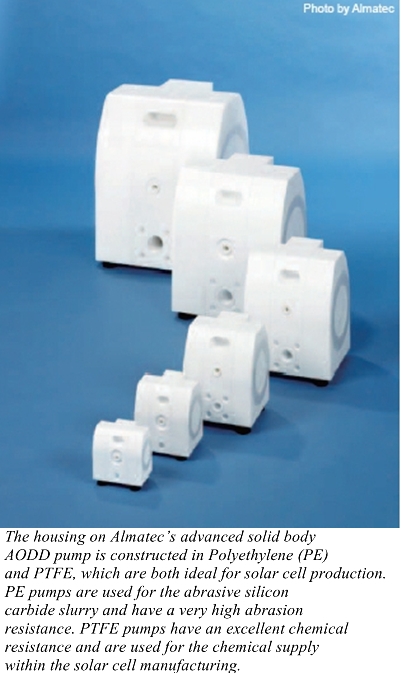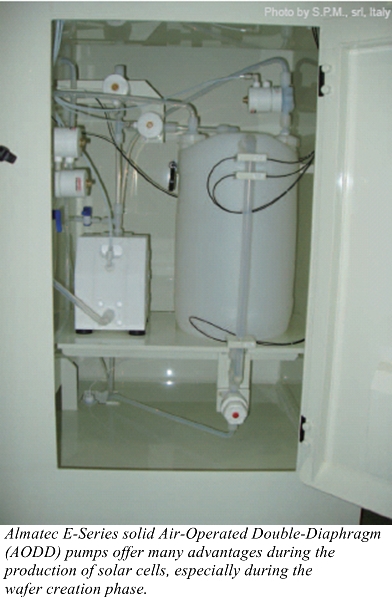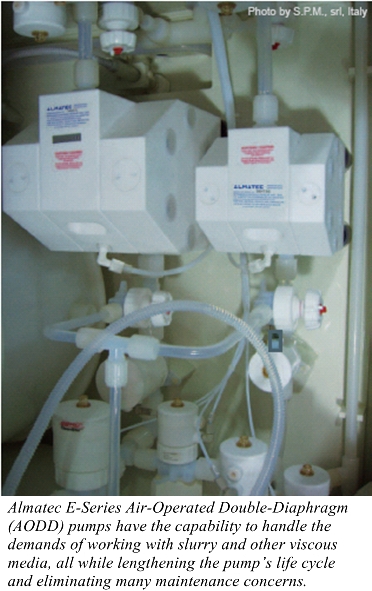By Rainer Frericks
.jpg)
.jpg) Since unscheduled shutdowns that result in production downtime can quickly accumulate into higher solar cell production costs and effect the overall bottom line, choosing the correct industrial process solutions to improve efficiencies and avoid downtime can go along way in keeping costs low. Therefore, it is crucial that the right components contribute to a solar cell plant’s operation, including the industrial pumps that do much of the heavy lifting during the various stages of the production process. Since unscheduled shutdowns that result in production downtime can quickly accumulate into higher solar cell production costs and effect the overall bottom line, choosing the correct industrial process solutions to improve efficiencies and avoid downtime can go along way in keeping costs low. Therefore, it is crucial that the right components contribute to a solar cell plant’s operation, including the industrial pumps that do much of the heavy lifting during the various stages of the production process.
Avoiding Pump Downtime
Although selecting the correct pump for each application during the solar cell production process is important, this has never been more true than during the wafer-creation phase of the process. While this phase of the process is precise, it can also be very harmful to pumping equipment and push a pump beyond its maximum capability. Selecting a pump that has not been specifically designed for this type of demanding application can result in unwanted maintenance costs and downtime.
 One of the many reasons pumping equipment is pushed to such extreme measures during the wafer creation process is because of the abrasive slurry that is used during the cutting process. This slurry, which is a mixture of glycol and powdered silicon carbide, is pumped into a wire saw machine and acts as the cutting agent between the silicone ingots and the wire saw machine as it cuts the silicone into wafers. Eventually, the slurry becomes polluted by silicon particles, iron and other byproducts from the sawing process, which makes it unusable. Since the slurry is one of the more expensive costs during the solar cell production process, rather than discard the slurry after use, many customers have invested in systems that utilize pumps to recover, recondition and reuse the slurry to help cut down the costs of production. Selecting a pump that is designed to handle abrasive slurries is ideal during this application. One of the many reasons pumping equipment is pushed to such extreme measures during the wafer creation process is because of the abrasive slurry that is used during the cutting process. This slurry, which is a mixture of glycol and powdered silicon carbide, is pumped into a wire saw machine and acts as the cutting agent between the silicone ingots and the wire saw machine as it cuts the silicone into wafers. Eventually, the slurry becomes polluted by silicon particles, iron and other byproducts from the sawing process, which makes it unusable. Since the slurry is one of the more expensive costs during the solar cell production process, rather than discard the slurry after use, many customers have invested in systems that utilize pumps to recover, recondition and reuse the slurry to help cut down the costs of production. Selecting a pump that is designed to handle abrasive slurries is ideal during this application.
In addition to being able to handle the slurry during the cutting process, pumps utilized during the wafer creation phase must also achieve functional reliability during the etching and cleaning process. During this process, abrasive liquids and sharp silicon particles must be continually drained, filtered and circulated by the pumping systems. Since this process is harsh, the pumps chosen to complete this task must have a solid construction and a high capacity to resist abrasion.
Over the years, a number of different types of pumps have been selected for use during the wafer creation phase. However, many of the processes involve both wet and dry applications, and few pumps are well suited for both. For example, pumps made with metal parts frequently corrode, and the sealing oil’s lubricating properties degrade, under the abrasive liquids and sharp materials associated with solar cell production. Some pumps also pulsate during liquid transfer, which can interrupt or clog the flow of material, resulting in pressure spikes and, ultimately, leakage.
Since pump malfunctions and maintenance downtime adds time and costs to solar cell manufacturing operations, getting just the right pump for use during this wafer creation phase is essential. Fortunately for those involved in the production of solar cells, there is a pumping technology available that offers the design, materials of construction, energy consciousness and operational efficiencies needed for this critical application. They are called Solid Body Air-Operated Double-Diaphragm (AODD) Pumps.
.jpg)
Pumps for Increasing Uptime
Solid AODD pumps offer many advantages during the production of solar cells, especially during the wafer creation phase. AODD pumps do not require electricity, are self-priming and can pump media ranging from wastewater to more viscous substances such as slurries and media with solids in suspension, like the hard sharp silicon particle byproduct of the wafer cutting and cleaning processes. AODD pumps are also designed to operate in rugged applications where most other pumps fail.
By utilizing a solid body construction, AODD pumps create a more reliable and efficient pump that has the capability to handle the demands of working with slurry, all while lengthening the pump’s life cycle and eliminating many maintenance concerns. The mechanical machining of a solid plastic block is economical thanks to modern Computer Numerical Controlled (CNC) technology that enables far tighter tolerances to be achieved than those pumps that use injection-molded parts.
This solid body construction provides a wide range of advantages to the end user; increased pump safety due to an innovative ring-tightening structure; increased product capacity; decreased air consumption; reduced noise level; optimized flow pattern; and a screwed-on or flanged pulsation dampener. The pump’s structure allows all housing bolts to be tightened against a diaphragm-sized ring on each side of the liquid housing. This creates a greater and more even compression at the sealing surfaces, which results in increased safety.
Other critical parts of the pump’s construction are the pump housing, valves and air valve. The pump housing can be made from many types of material. Some popular plastic materials of construction are Teflon®, polypropylene, polyethylene and acetal. Stainless steel, aluminum and cast iron can also be used, but they are not as compatible with the chemicals and abrasives used in solar cell construction. The pump’s check valves are a ball type that fit snugly with the valve seat to ensure that the pump chambers are completely sealed. The air valve, which is sealed off from the pump chambers by the diaphragm, handles the variable displacement of air behind the diaphragm.


In addition, the characteristics of the AODD pump design offer many other benefits, among them the absence of an axle seal or other lubricated parts, which allow the pumps to run dry; the pump’s capacity can be adjusted by increasing or decreasing the air pressure or air volume; and the pump will shut down automatically if the discharge pressure exceeds the air pressure.
Designed specifically to handle the pumping requirements at solar cell plants is the new E-Series line of pumps offered by Almatec®, Kamp-Linfort, Germany. E-Series pumps are an advanced type of solid body AODD pumps that have been designed specifically for the manufacture of solar-cells. The housing on Almatec’s advanced solid body AODD pump is constructed in Polyethylene (PE) and PTFE, which are both ideal for solar cell production. PE pumps are used for the abrasive silicon carbide slurry and have a very high abrasion resistance. PTFE pumps have an excellent chemical resistance and are used for the chemical supply within the solar cell manufacturing.
The diaphragm using in advanced solid body AODD pumps are available in EPDM or PTFE/EPDM, while components like ball valves are available in EPDM or PTFE, with the cylinder valves constructed of PTFE. The E-Series pumps are available in seven sizes with maximum delivery volumes up to 48 m3/h (800 lpm / 210 gpm).
The advanced solid body AODD pumps also feature a patented maintenance-free air-control system, called PERSWING P®, which allows for improved performance in solar-cell manufacturing processes. These pumps are self-priming and provide gentle displacement of fluids. The compact, solid design makes these advanced AODD pumps easy to install and provide unattended operation with long service life. The pumps are easy to start up and also include an integrated muffler. Options such as a screw-on pulsation damper, draining system, barrier chamber system, diaphragm monitor, stroke counting and flange connection are also available.
It’s a simple fact that if solar cells are expensive to produce, they will also be expensive to buy, limiting the solar industry’s growth potential. Selecting the right pump for use in solar cell applications can help to ensure that the production process is completed in the most cost-effective, error-free and efficient manner possible. Putting an end to undesired production downtimes that can incur enormous production costs is a must when your bottom line depends on it. So when solar cell manufactures are looking for pumping solutions they can totally rely on to be efficient and maintenance free, the clear choice is to utilize plastic air-operated diaphragm pumps.
Rainer Frericks is with Almatec Maschinenbau GmbH (www.almatec.de), one of the world’s leading manufacturers of solid body plastic air-operated diaphragm pumps. Almatec is part of Dover Corporation’s Pump Solutions Group (PSG™). PSG is comprised of Almatec®, Wilden®, Blackmer®, Griswold™, Neptune™, EnviroGear® and Mouvex®.
For more information, please send your e-mails to pved@infothe.com.
ⓒ2011 www.interpv.net All rights reserved. |



